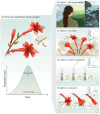The Equilibrium Conundrum
- PMID: 41176760
- PMCID: PMC12579923
- DOI: 10.1111/ele.70232
The Equilibrium Conundrum
Abstract
The idea that natural systems tend to be at equilibrium dates back to the origin of the field of ecology and continues to underlie most ecological theory. However, empirical evidence for equilibrium dynamics in nature and in experiments is surprisingly elusive. Here, we address this conundrum by first exploring the history of equilibrium in ecological theory and the evidence for equilibrium dynamics in natural systems. We then search the literature to quantify how empiricists deal with equilibrium in their research and address barriers to integrating the concept of equilibrium into empirical work by providing step-by-step instructions for determining whether a population is at equilibrium. Next, we lay out three ways that equilibrium is embedded in theory, and for each, outline when meeting the equilibrium assumption in empirical tests is critical for scientific inference, and when it may be possible to relax this assumption. And finally, we present concrete steps that empiricists and theoreticians can each take in order to meet in the middle when it comes to equilibrium. We hope that this paper will stimulate new discussions from researchers from across the theory-empirical divide about this longstanding issue.
Keywords: balance of nature; empirical tests; equilibrium; mathematical models; theory.
© 2025 The Author(s). Ecology Letters published by John Wiley & Sons Ltd.
Figures





References
-
- Aagaard, K. , Lockwood J. L., and Green E. J.. 2016. “A Bayesian Approach for Characterizing Uncertainty in Declaring a Population Collapse.” Ecological Modelling 328: 78–84.
-
- Ampatzidis, G. , and Ergazaki M.. 2018. “Challenging Students' Belief in the ‘Balance of Nature' Idea: The Emergence of a Design Theory.” Science & Education 27: 895–919.
-
- Arani, B. M. , Carpenter S. R., Lahti L., Van Nes E. H., and Scheffer M.. 2021. “Exit Time as a Measure of Ecological Resilience.” Science 372: eaay4895. - PubMed
-
- Bailey, V. 1931. “The Interaction Between Hosts and Parasites.” Quarterly Journal of Mathematics 2: 68–77.
-
- Barabás, G. 2024. “Parameter Sensitivity of Transient Community Dynamics.” American Naturalist 203: 473–489. - PubMed
Publication types
MeSH terms
Grants and funding
LinkOut - more resources
Full Text Sources

